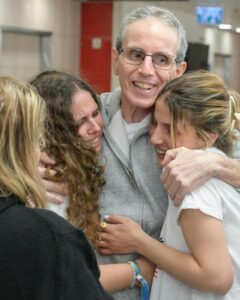By Andrew Adler
Community Editor

Freed hostage Ohad Ben Ami embraces his three daughters after being held captive by Hamas for 491 days (Facebook)
Not long ago I read an article in the English-language edition of Haaretz — Israel’s uber-liberal, anti-Netanyahu newspaper — that told how hostages drew on faith to sustain them in captivity. It was a remarkable chronicle, made even more emotionally affecting because many of the released hostages continued, and even deepened, their levels of formal observance.
“Faith is what strengthened the hostages, not a desire for revenge,” Brit Yakobi, identified as “a leader of the activist group Hasmol Haemuni (“the religious left”) and a grant officer at the New Israel Fund,” wrote in a March 5, 2025 opinion piece.
“They were bolstered by their connection to the ancient chain of tradition, a belief in the value of redeeming captives and of choosing life – Jewish values that are so sadly lacking in religious politicians like Finance Minister Bezalel Smotrich and Itamar Ben-Gvir.”
None of us, certainly not myself, can fathom the extent of the suffering these men and women endured under Hamas. They were starved, beaten, sexually abused, and subjected to psychological anguish that could easily shatter hope into a thousand piercing shards. A few weeks under such miserable conditions might break even the most resolute of souls. A few months? A year or more? Who could withstand the ravages of captivity for so long?
Yet somehow, a scattering of these hostages refused to break. They reached into themselves, and each other, to reclaim a measure of spiritual energy. They discovered (or rediscovered) their faith.
“Ohad Ben Ami and Sasha Troufanov each offered their own account of how they discovered faith in captivity,” Yakobi recounted. “Agam Berger wouldn’t eat unleavened bread on Pesach. Eli Sharabi said he started to recite the Shema prayer every morning after he was kidnapped. And there is a wealth of other examples – survivors who say that faith strengthened and sustained them in the hell of Hamas captivity.”
I was struck by how these captives drew strength from elements of normative Judaism. Another story told how one hostage would say the blessings recited when donning tefillin, which begin: Blessed are You, Lord our G-d, King of the Universe, Who has sanctified us with his Commandments, and commanded us to put on tefillin.
Of course, no actual tefillin was available amid the dark, dank tunnels under Gaza. That absence, however, became irrelevant as the physical was transmuted into the metaphysical — reality taking on an entirely new structure. At that moment, the imagined leather straps wrapping the arm and the leather boxes on the arm and forehead were present. The invisible had become visible, the mind’s eye supplying all that was needed.
Another Haaretz story, this one written by Rachel Fink and published on March 10, told how before he was freed, hostage Omer Shem Tov grasped on to the wondrous holiness of Shabbat:
“In a rundown apartment deep in Gaza, a young Jewish man sits on the dusty floor, carefully scraping salt off the handful of pretzels he was given days ago. Soon, he will place a square of toilet paper on his head as a makeshift yarmulke and whisper the blessing he has recited at his family’s Shabbat table since childhood.
“Blessed are You, Adonai our God, Sovereign of all, Creator of the fruit of the vine,” he murmurs, sipping from the small bottle of grape juice his captors have inexplicably provided. He sprinkles the salt onto his daily ration of pita, taking small bites to make it last.”
And then came this arresting epilogue:
“As he settles into the murky darkness, his flashlight off for the next 25 hours, his mother is uttering the same prayers some 80 kilometers (50 miles) away. Without communicating, both have recently committed to observing Shabbat, according to its traditional religious precepts.”
Tradition, so often dismissed as creaky anachronism, here was stunningly pertinent. Two generations, one free and one imprisoned, found a lifeline within tenets of observance that have thrived through the ages.
Faith is a tricky notion. It can be expressed in trite aphorisms — (“Faith is believing in things when common sense tells you not to,” goes a favorite line from “Miracle on 34th Street) — or encyclopedic (read, if you’re brave enough, the entry on “Faith” in the Stanford Encyclopedia of Philosophy).
All that mattered in Gaza, however, was a willingness to make a leap to a measure of belief. “Amid the horrors, the hostages’ testimonies often shared a recurrent theme: The decision to participate in Jewish rituals, often taken by captives from secular backgrounds.,” Haaretz’s Fink observed. Call it a leap over the chasm of despair, where on the other side, faith awaits.
Andrew Adler is the Managing Editor of Community.



